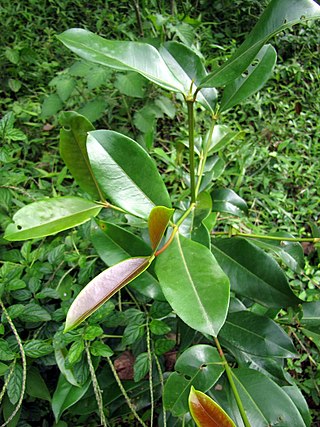Canarium fuscocalycinum is a tree of Borneo in the incense tree family Burseraceae. The specific epithet fuscocalycinum is from the Latin meaning "dark calyx".

Carallia is a genus of trees in the family Rhizophoraceae.

Euonymus cochinchinensis is a tree of tropical Asia in the staff vine family Celastraceae. The specific epithet cochinchinensis refers to the species being native to Indo-China.
Dipterocarpus rigidus grows as a large tree up to 50 metres (160 ft) tall, with a trunk diameter of up to 1 metre. Bark is rust-brown. The fruits are roundish, up to 5 cm (2 in) in diameter. Habitat is mixed dipterocarp forest on low hills near coasts. D. rigidus is found in Sumatra, Peninsular Malaysia and Borneo.
Barringtonia lanceolata grows as a tree up to 30 metres (100 ft) tall, with a trunk diameter of up to 60 centimetres (24 in). The bark is brown, grey or reddish brown and has been used as fish poison. The fruits are ovoid or fusiform, up to 10.5 cm (4 in) long. Habitat is forest from sea level to 1,700 metres (5,600 ft) altitude. B. lanceolata is endemic to Borneo.
Planchonia grandis grows as a tree up to 33 metres (110 ft) tall, with a trunk diameter of up to 1 metre. The bark is reddish brown, grey or white. The flowers are greenish white. Habitat is lowland and mangrove forest. P. grandis is found in Sumatra, Peninsular Malaysia and Borneo.
Chionanthus pubicalyx grows as a tree up to 40 metres (130 ft) tall, with a trunk diameter of up to 30 centimetres (12 in). The bark is whitish or grey. The fragrant flowers are white or pale yellow. Fruit is purple, ovoid, up to 2 centimetres (1 in) long. Habitat is forests from sea level to 1,600 metres (5,000 ft) altitude. C. pubicalyx is endemic to Borneo.
Madhuca curtisii is a tree in the family Sapotaceae.
Madhuca hirtiflora is a plant in the family Sapotaceae. The specific epithet hirtiflora means "hairy flowers".
Diospyros piscicapa is a tree in the family Ebenaceae. It grows up to 27 metres (90 ft) tall. The twigs are stout and smooth. Male inflorescences feature one to three flowers with a tubular calyx. The fruits are ellipsoid to round, up to 5 cm (2 in) in diameter. The fruit is locally used to stun fish. Habitat is lowland mixed dipterocarp forests from sea level to 700 metres (2,300 ft) altitude. D. piscicapa is endemic to Borneo.
Aglaia rufibarbis is a small tree in the family Meliaceae. It grows up to 5 metres (20 ft) tall with a trunk diameter of up to 5 centimetres (2 in). The bark is usually grey and pale brown, sometimes dark brown. The fruits are roundish, up to 2 cm (1 in) in diameter. The specific epithet rufibarbis is from the Latin meaning "red beard", referring to the reddish brown hairs of the indumentum. Habitat is mixed dipterocarp forests from 100 metres (300 ft) to 250 metres (800 ft) altitude. A. rufibarbis is found in Peninsular Malaysia and Borneo.
Chisocheton ruber is a tree in the family Meliaceae. The specific epithet ruber is from the Latin meaning "red", referring to the flowers.
Chisocheton setosus is a tree in the family Meliaceae. The specific epithet setosus is from the Latin meaning "with bristly hairs", referring to the fruits.
Prasoxylon rigidum is a tree in the family Meliaceae. The specific epithet rigidum is from the Latin meaning "rigid", likely referring to the leaflets.
Xanthophyllum purpureum is a plant in the family Polygalaceae. The specific epithet purpureum is from the Latin meaning "purple", referring to the flowers.
Canarium grandifolium is a tree in the family Burseraceae. The specific epithet grandifolium is from the Latin meaning "large leaf".
Euonymus acuminifolius is a plant in the family Celastraceae. The specific epithet acuminifolius is from the Latin meaning "long-pointed leaves".
Carallia coriifolia is a tree of Borneo in the family Rhizophoraceae. The specific epithet coriifolia is from the Latin meaning "leathery leaf".
Campnosperma squamatum is a tree in the cashew and sumac family Anacardiaceae. The specific epithet squamatum means "scaly", referring to the leaf surface.
Gluta laxiflora is a tree of Borneo in the cashew and sumac family Anacardiaceae. The specific epithet laxiflora is from the Latin meaning "loose flowers", referring to the arrangement of the flowers.

